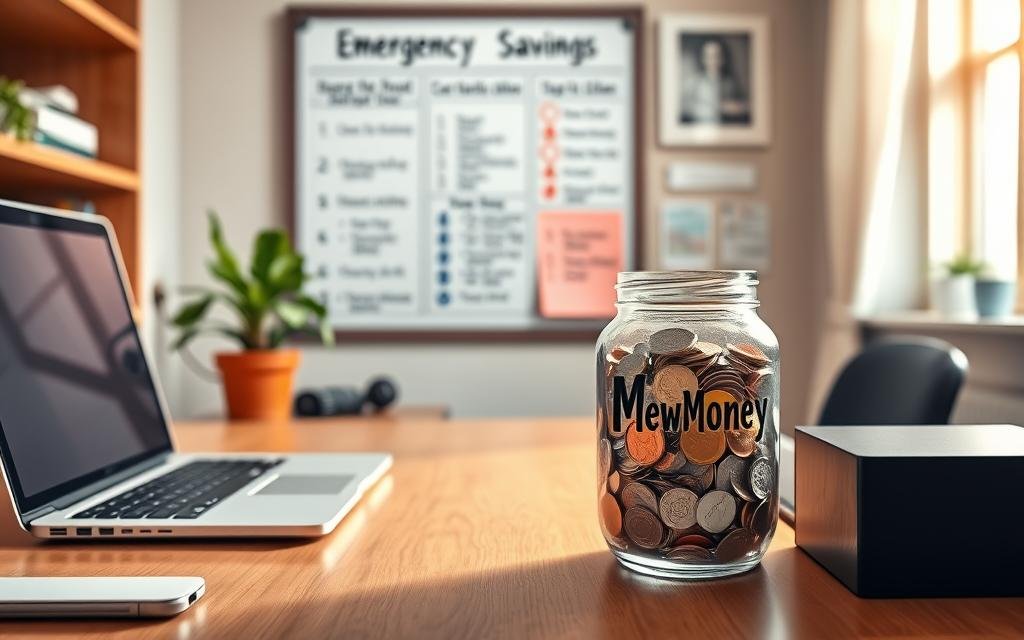Having a solid emergency fund is key for financial security and peace of mind. It protects against unexpected expenses and job losses. This way, you can face life’s challenges with confidence.
Building an emergency fund means having enough savings for three to six months. This provides a safety net against emergencies. Start by saving a realistic amount, like $50 or $100 a month. This is about $2 to $3 a day.
Effective strategies include automating savings and using a part of your paycheck for savings. These habits help you save consistently.
Use a separate, interest-bearing, FDIC-insured account for your emergency fund. This keeps it accessible but less tempting for daily spending. During America Saves Week, aim to save 20% of your income for better financial stability.
The goal is to save enough to cover living expenses for three to six months. Aim to save 10–20% of your monthly income for an emergency fund. By focusing on emergency fund strategies, you can reduce financial stress and reach your goals.
Proven emergency fund strategies help you take control of your finances and secure your future. It’s about understanding the importance of emergency funds, making a plan, and sticking to it. With the right approach, you can overcome financial hurdles and achieve stability in the long run.
Key Takeaways
- Building an emergency fund is essential for financial security and peace of mind.
- Saving a realistic amount, such as $50 or $100 a month, can help create a solid emergency fund.
- Automating transfers from checking to savings accounts can enhance consistent savings behavior.
- Creating a separate, interest-bearing, FDIC-insured savings or money market account can ensure accessibility and minimize temptation to use emergency funds for daily expenses.
- Prioritizing emergency fund strategies, such as building an emergency fund and saving for emergencies, can reduce financial stress and increase chances of meeting financial goals.
- Implementing proven emergency fund strategies, such as the 50/30/20 rule, can help individuals achieve long-term financial stability.
Understanding the Fundamentals of Emergency Funds
Creating a rainy day fund is key to being financially prepared. It helps deal with unexpected costs and financial surprises. An emergency savings plan should cover basic needs like rent, utilities, and food during tough times.
Knowing what counts as a financial emergency is important. This includes car fixes, medical bills, or losing a job. Having an emergency fund can ease financial worries and bring peace of mind. Studies show people with emergency funds bounce back faster from financial hits than those without.
What Qualifies as a True Financial Emergency
A true financial emergency is an urgent event that affects your financial stability. Examples include:
- Car repairs or accidents
- Medical bills or emergencies
- Job loss or reduction in income
- Home repairs or maintenance
Why Traditional Savings Accounts Aren’t Enough
Traditional savings accounts might not be enough for emergencies. They often have small balances and aren’t always easy to access. A rainy day fund for emergencies ensures you have funds for unexpected costs.

The Psychology Behind Emergency Savings
The psychology of emergency savings is complex. Having a safety net can lower financial stress and boost mental well-being. By focusing on financial readiness and building a rainy day fund, you can handle unexpected costs better and achieve financial stability.
| Emergency Fund Goal | Recommended Amount |
|---|---|
| Spending shocks | Half a month’s worth of living expenses or $2,000, whichever is greater |
| Income shocks | 3 to 6 months’ worth of living expenses |
How Much Should You Really Save for Emergencies
Figuring out how much to save for emergencies can be tough. Experts recommend starting with a small goal, like $500. Then, aim to save three to six months’ worth of expenses. This helps cover unexpected costs, like car repairs or medical bills.
To build an emergency fund, here are some tips:
- Begin by saving at least $1,000 for basic needs
- Strive for an emergency fund of 3 months of expenses if single, or 6 months if you have dependents or worry about job security
- Use savings from cutting spending to quickly grow your emergency fund
For instance, saving $10 a week adds up to over $500 in a year. By following these steps, you can save enough to handle unexpected bills without debt.

The secret to building an emergency fund is to start small and keep at it. By following these emergency fund tips, you can create a safety net. This will give you peace of mind and financial security.
Proven Emergency Fund Strategies for Long-term Success
Having a solid emergency fund is key for managing unexpected expenses and financial stability. The importance of emergency savings is huge. It acts as a safety net during financial ups and downs.
There are many ways to build a strong emergency fund. You can use the bucket method, the ladder approach, or the 50/30/20 rule. These strategies help you save effectively and manage your funds well.
The Bucket Method
This method sorts expenses into must-haves and nice-to-haves. Then, it sets aside money for the must-haves. This way, you’re sure you can cover your basic needs in an emergency.
The Ladder Approach
This strategy sets up a series of savings goals. You start with a small goal, like saving $1,000. Then, you aim for three months’ worth of expenses, and eventually six months’ worth.
The 50/30/20 Rule Applied to Emergency Savings
This rule suggests using 50% of your income for needs, 30% for wants, and 20% for savings and debt. Applying it to emergency savings helps you focus on saving and reaching your goals.

| Strategy | Description |
|---|---|
| Bucket Method | Divide expenses into categories and allocate funds according to need |
| Ladder Approach | Set multiple savings goals, with each goal building on the previous one |
| 50/30/20 Rule | Allocate 50% of income towards essential expenses, 30% towards non-essential expenses, and 20% towards savings and debt repayment |
Choosing the Right Account for Your Emergency Fund
Choosing the right account for saving for emergencies is key. There are many options, making it hard to pick the best one. High-yield savings accounts are often recommended because they offer easy access and good interest rates. They can earn up to 4% or more, which is great for emergency funds.
When picking an account, think about liquidity, interest rates, and fees. You need your money to be easy to get in emergencies. Also, you want it to earn a good interest rate. Here are some good options:
- High-yield savings accounts: These offer good interest rates and easy access.
- Money market accounts: They have higher interest rates than regular savings but might need a minimum balance.
- Traditional savings accounts: They are safe but often have lower interest rates and fewer benefits.
It’s important to carefully look at your options and pick the best one for your emergency fund. Look at interest rates, fees, and minimum balances to get the best deal. The right account helps you save more and be ready for unexpected expenses.

Remember, saving for emergencies is a must for any financial plan. By focusing on your emergency fund and picking the right account, you can avoid financial shocks. Start building your emergency fund today for a more secure financial future.
| Account Type | Interest Rate | Fees | Liquidity |
|---|---|---|---|
| High-Yield Savings | 4% or greater | Low or no fees | Easy access |
| Money Market | 3-4% | Low or no fees | Easy access |
| Traditional Savings | 1-2% | Low or no fees | Easy access |
Building Your Emergency Fund from Scratch
Starting an emergency fund might seem hard, but it’s key to being financially ready. Begin with a small goal, like saving $1,000. Make saving automatic to keep moving forward.
Recent data shows 41% of adults over 18 use savings for unexpected costs. Yet, 27% have no savings. Start by cutting unnecessary expenses and saving a bit each week. Saving just $10 a week is a good start.
To save faster, try saving a fixed amount daily, like $5. This can add up to $1,825 in a year. Also, focus on paying off debts before saving. These small steps can lead to big savings.

Building an emergency fund takes time, so be patient. Start small and make saving automatic. This way, you’ll be on the path to financial readiness.
| Monthly Savings | Time to Reach $1,000 |
|---|---|
| $10 | 100 months |
| $50 | 20 months |
| $100 | 10 months |
Common Pitfalls to Avoid When Saving for Emergencies
When you’re setting up an emergency savings plan, watch out for common mistakes. One big error is saving too much for emergencies. This can slow down your financial growth. Experts say having a plan is key, but don’t forget to balance it with other financial goals.
A good emergency savings plan should have a rainy day fund for three to six months’ living costs. But, some people might need to save more. To avoid saving too much, consider these tips:
- Check and tweak your emergency fund savings often to keep it aligned with your long-term goals.
- Don’t use your emergency fund for things you don’t really need.
- Look into high-yield savings accounts to grow your money without losing access to it.
By being aware of these pitfalls and making a balanced emergency savings plan, your rainy day fund will help protect you from unexpected money troubles.

Advanced Techniques for Emergency Fund Management
Managing an emergency fund well is key to staying financially stable. It’s important to find a balance between keeping funds easily accessible and earning interest. This ensures you can use the money when you need it and also grow your savings.
Using multiple accounts for different savings goals is another smart move. This makes it easier to keep track of your emergency fund. Tips for establishing an emergency fund include starting small and saving regularly. Also, look into high-yield savings accounts to boost your earnings.
Don’t forget about protecting your savings from inflation. Investing in assets like precious metals or real estate can help. This way, your emergency fund’s value stays strong over time.

| Account Type | Interest Rate | Liquidity |
|---|---|---|
| High-Yield Savings | 3-5% APY | High |
| Money Market | 2-4% APY | Medium |
| Short-Term CD | 4-6% APY | Low |
By using these advanced strategies, you can build a strong emergency fund. This fund will give you peace of mind and financial security. The most important thing is to make saving a priority and stay consistent.
When and How to Use Your Emergency Fund
Handling unexpected expenses is key to emergency fund strategies. Knowing when to tap into your emergency fund is vital. It’s meant for sudden costs like medical bills or car repairs.
Deciding if an expense is an emergency depends on its financial impact. If it’s vital and can’t wait, it’s likely an emergency. For instance, if you lose your job, your emergency fund can help with rent, utilities, and food.
Here are some valid reasons to use your emergency fund:
- Medical emergencies, such as hospitalization or surgery
- Car repairs or replacement
- Job loss or reduction in income
- Home repairs or maintenance
Having a solid emergency fund is key to managing unexpected expenses. It offers peace of mind and prevents debt. By using your emergency fund smartly, you’re ready for any financial hurdle.

The main aim of an emergency fund is to act as a financial safety net. By wisely using your emergency fund and following emergency fund strategies, you’re always ready for the unexpected.
| Emergency Fund Scenario | Recommended Action |
|---|---|
| Medical Emergency | Use emergency fund to cover medical expenses |
| Car Repair | Use emergency fund to cover car repair costs |
| Job Loss | Use emergency fund to cover essential expenses |
Rebuilding Your Emergency Fund After Using It
After you’ve used your emergency fund, it’s vital to rebuild it. This ensures you’re ready for any future unexpected costs. Start by making a recovery plan and adjusting your savings strategy based on what you’ve learned. Look at your budget and find ways to spend less so you can save more.
Building an emergency fund takes discipline and patience, but it’s key for financial stability. Begin by setting a realistic savings goal, like saving a certain amount each month. You might also want to set up automatic transfers from your checking to your savings account.
Recovery Strategies
- Review and adjust your budget to identify areas for cost-cutting
- Consider temporary pauses on debt payments to focus on rebuilding your emergency fund
- Take advantage of windfalls, such as bonuses or tax refunds, to boost your savings
- Explore ways to increase your income, such as taking on a side job or freelancing
By using these strategies and sticking to your plan, you can rebuild your emergency fund. This will help you handle unexpected expenses better in the future. Remember, building an emergency fund is a continuous effort that needs regular checks and adjustments to stay on track.

It’s also key to think about the current economic situation and how it affects your savings. With interest rates low, saving and investing wisely is more critical than ever. By focusing on your emergency fund and making steady progress, you can achieve financial stability and security.
| Emergency Fund Goal | Monthly Savings | Timeframe |
|---|---|---|
| $1,000 | $100 | 10 months |
| $3,000 | $200 | 15 months |
Emergency Fund Considerations for Different Life Stages
As people move through life, their emergency savings needs change. Young adults, just starting work, might need a smaller fund. But as they grow in their careers and have families, they need more for expenses and dependents.
The right emergency fund size depends on your situation. Families often need more than singles. Experts suggest saving three to six months’ worth of expenses. But, this can vary based on your life stage and finances.
It’s important to understand these changes for good financial preparedness. By recognizing your evolving needs, you can plan better. Whether you’re starting out or nearing retirement, saving for emergencies is key to financial security.
Here are some life stages and their unique emergency fund needs:
– Young adults: Start with a small fund and work on debt.
– Families: Save for emergencies and long-term goals like education.
– Retirees: Make sure your fund covers living costs, as income may drop.
| Life Stage | Emergency Fund Considerations |
|---|---|
| Young Adults | Starter fund, debt repayment |
| Families | Increased fund size, education savings |
| Retirees | Covering essential expenses, reduced income |
Maintaining Your Emergency Fund in Economic Uncertainty
Having a strong emergency fund is key when the economy is unpredictable. With emergency fund strategies, you can face economic ups and downs with confidence. In 2022, 37% of Americans couldn’t handle a sudden $400 expense. This shows how vital saving for emergencies is.
To keep your emergency fund strong, try these tips:
- Start small: Aim to save at least $1,000 as a starting point for your emergency fund.
- Automate your savings: Set up a regular transfer from your checking account to your savings or investment account.
- Take advantage of high-yield savings accounts: Consider opening a savings account with a high APY, such as Lafayette Federal’s 5.61% APY, to grow your emergency fund over time.
Also, adjust your emergency fund plans when inflation hits. Here’s how:
ьте
| Income Type | Suggested Emergency Fund Amount |
|---|---|
| Single-income household | At least six months of expenses |
| Two-income household | Three to six months of expenses |
| Retirees | One to two years of living expenses |
By using these emergency fund strategies and adjusting for economic changes, you can keep a financial safety net. Always check and update your emergency fund to match your current financial situation.
Technology Tools and Apps for Emergency Fund Management
Creating a rainy day fund is key to any emergency savings plan. Digital banking and financial tools make it easier to manage your fund. The Fidelity Investments 2025 Financial Resolutions Study found 79% of Americans aimed to grow their emergency funds in 2025.
Many technology tools and apps can help manage your emergency fund. YNAB (You Need a Budget), Rocket Money, and Ibotta are popular choices. They offer budgeting, expense tracking, and cashback rewards to build your fund. For instance, YNAB costs $14.99 a month or $109 a year, with a 34-day free trial.
When picking a tool or app for your emergency fund, think about these factors:
- Fees: Look for apps with low or no fees, like YNAB’s 34-day free trial.
- Features: Choose the features you need, such as budgeting, expense tracking, and cashback rewards.
- Security: Ensure the app is secure and protects your financial info.
Also, consider online savings accounts or mobile banking apps for your emergency fund. Chime offers a 2% APR on savings accounts, higher than the national average of 0.42%. Acorns Silver and Gold plans have APYs of 2.57% and 4.05% for emergency funds.
Using these technology tools and apps can help you create a solid emergency savings plan. Start building your rainy day fund today.
| App | Features | Fees |
|---|---|---|
| YNAB | Budgeting, expense tracking | $14.99/month or $109/year |
| Rocket Money | Budgeting, expense tracking, cashback rewards | $6-$12/month |
| Ibotta | Cashback rewards | Free, with minimum $20 payout threshold |
Conclusion: Taking Action on Your Emergency Fund Strategy
Building a strong emergency fund is key to financial stability. Saving a part of your income helps create a safety net. This protects you and your family from sudden costs or job losses.
Studies show that those with emergency funds avoid high-interest loans and debt. This is true during tough times.
Starting your financial journey is easy. You can begin saving, even if it’s a little each month. Experts say aim to save three to six months’ worth of expenses. It might seem hard, but with regular effort, you can do it.
Having an emergency fund brings peace of mind and less financial worry. It also gives you confidence to handle unexpected events. Make saving for emergencies a priority to secure your financial future. Begin today, and your future self will be grateful.
FAQ
What qualifies as a true financial emergency?
True financial emergencies include unexpected medical bills, car repairs, job loss, or other sudden events. These situations require quick access to money to avoid financial trouble.
Why are traditional savings accounts not enough for emergency funds?
Traditional savings accounts often have low interest rates. They may not offer the quick access and liquidity needed for emergency funds.
How does the psychology of saving for emergencies impact financial preparedness?
Saving for emergencies can be tough due to procrastination or fear. These psychological barriers can make it hard to build and keep a strong emergency fund.
How much should I save for emergencies?
It’s common to aim for three to six months’ living expenses in an emergency fund. But, the right amount depends on your job, family, and other financial needs.
What are some proven strategies for emergency fund management?
Good strategies include the bucket method, the ladder approach, and using the 50/30/20 rule. These help manage your emergency fund effectively.
What type of account is best for an emergency fund?
High-yield savings accounts are best for emergency funds. They offer easy access and competitive interest rates.
How can I build an emergency fund from scratch?
Start with a small goal, like saving
FAQ
What qualifies as a true financial emergency?
True financial emergencies include unexpected medical bills, car repairs, job loss, or other sudden events. These situations require quick access to money to avoid financial trouble.
Why are traditional savings accounts not enough for emergency funds?
Traditional savings accounts often have low interest rates. They may not offer the quick access and liquidity needed for emergency funds.
How does the psychology of saving for emergencies impact financial preparedness?
Saving for emergencies can be tough due to procrastination or fear. These psychological barriers can make it hard to build and keep a strong emergency fund.
How much should I save for emergencies?
It’s common to aim for three to six months’ living expenses in an emergency fund. But, the right amount depends on your job, family, and other financial needs.
What are some proven strategies for emergency fund management?
Good strategies include the bucket method, the ladder approach, and using the 50/30/20 rule. These help manage your emergency fund effectively.
What type of account is best for an emergency fund?
High-yield savings accounts are best for emergency funds. They offer easy access and competitive interest rates.
How can I build an emergency fund from scratch?
Start with a small goal, like saving $1,000. Then, increase your savings rate and automate it. This helps build your emergency fund step by step.
What are some common pitfalls to avoid when saving for emergencies?
Avoid overfunding your emergency fund at the cost of other goals. Also, regularly review and adjust your emergency fund strategy to stay on track.
How can I use my emergency fund effectively during a crisis?
In a true emergency, check if the expense is valid. Then, withdraw the needed funds from your emergency fund. Have a plan to rebuild it after the crisis.
How do emergency fund considerations differ across life stages?
Emergency fund needs change with life stages. They depend on income stability, family, and retirement goals. So, strategies must be tailored for singles, families, and retirees.
,000. Then, increase your savings rate and automate it. This helps build your emergency fund step by step.
What are some common pitfalls to avoid when saving for emergencies?
Avoid overfunding your emergency fund at the cost of other goals. Also, regularly review and adjust your emergency fund strategy to stay on track.
How can I use my emergency fund effectively during a crisis?
In a true emergency, check if the expense is valid. Then, withdraw the needed funds from your emergency fund. Have a plan to rebuild it after the crisis.
How do emergency fund considerations differ across life stages?
Emergency fund needs change with life stages. They depend on income stability, family, and retirement goals. So, strategies must be tailored for singles, families, and retirees.

